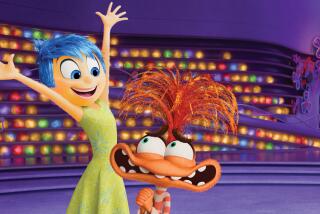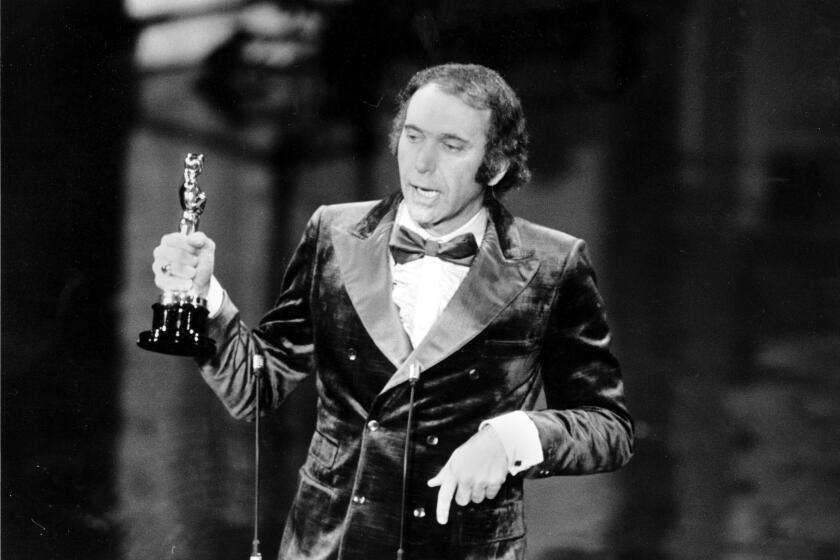MOVIES : What Took So Long? : Randa Haines waited four years before taking on another movie after ‘Children of a Lesser God.’ She rejected many scripts, then chose ‘The Doctor,’ about a surgeon who becomes a patient himself. It reunited her with William Hurt.
Randa Haines sits high in a director’s chair--a tall, slim woman with a cascade of dark curly hair and an array of silver and turquoise bracelets--the only woman in a semicircle of men. Peering at the screen in the final days of post-production on “The Doctor”--her first feature movie since the much-acclaimed “Children of a Lesser God” five years ago, and her second movie starring William Hurt--her voice is soft, her manner calm and long fingers seemingly do a dance in the air as she makes fine-point decisions about which sounds she wants where.
Yet these are crunch days for Haines. Along with 15-hour days required when Disney’s Touchstone Pictures moved up the movie’s release date by more than a week to this Wednesday, she knows the industry is wondering: Can she do it again? Or was “Children of a Lesser God” “just a fluke?” Despite a high quotient of confidence, Haines sometimes wonders herself.
And there’s another question: What took so long?
With “Children of a Lesser God,” drawn from Mark Medoff’s 1980 Tony-winning play about deafness but changed to a significant degree for the screen, Haines became the first woman to direct a best-picture Oscar nominee, though, like Penny Marshall (“Awakenings”) this year, she was not nominated herself. The movie drew five nominations, including a best-actor nomination for Hurt, and Marlee Matlin won an Oscar as best actress.
“In a way the second movie is harder than the first because there is that pressure to do as well or to do better,” Haines says on a fast lunch break at CBS-MTM in Studio City. “Second movies are (sometimes) disappointing. So it’s scary. Everybody watches to see whether (talent’s) just a fluke. Or that she did it right the first time.”
The movie she finally chose to direct is loosely adapted from the book “A Taste of My Own Medicine” by Dr. Edward E. Rosenbaum, an Oregon internist who developed cancer of the larynx at 70 and wrote about his experiences as a patient.
The film’s doctor, Hurt’s Jack McKee, is 40 and at the top of his game. He’s a cool, talented heart surgeon who plays rock ‘n’ roll during operations, and gives the early frames of the movie a “MASH”-like quality. “Surgery is judgment,” the surgeon pronounces to the residents who trail in his wake. “To judge you have to be detached.”
Christine Lahti plays McKee’s wife Anne, whom he also keeps at a distance. Elizabeth Perkins is June Ellis, dying of brain cancer, who teaches him how to see patients as people first, to accept illness as another part of life even while fighting it, and to enjoy that life, however fragile. She becomes McKee’s closest friend and the person who helps him shed detachment and grow into a caring human being.
But it is Hurt who dominates this movie. The actor, who won an Oscar for his “Kiss of the Spider Woman” and a nomination as well for “Broadcast News,” is in every frame.
By many accounts, Hurt gave Haines so much trouble on the set of “Children” that it was a surprise they would work together again. Indeed Hurt said he was “a little bit surprised and just gladdened” when she phoned him in Australia where he was making a movie. “I didn’t know if she wanted to get back in the water with me . . . because I didn’t check my bets, I didn’t really pull any punches (the last time). And sometimes people get stung and they don’t want to come back.”
According to Haines, Hurt has changed. “He’s changed a lot in the last few years. I mean it’s personal stuff, just working on himself. . . . He used to have more of a need for conflict, for edge .”
And Hurt, who praises Haines for “the patience and the courage” to wait for quality work, concurs: “That was another time.” Asked what happened, what changed, Hurt said with a light laugh, “Oh, me . You get riper (more mature).” As for the personal stuff, he demurs: “I feel blessed; I’ll tell you that much.”
For Haines, the central idea of “The Doctor” is the transformation of the surgeon who “literally holds people’s hearts in his hands. And what the whole story is about is a man who gets a new heart.
“There is just something mythological about the story,” says Haines. “He’s a God-like character who reaches in, fixes other people’s hearts and gives them life. In a way he probably believes he’s immortal himself.”
“And that led me to thinking,” the director continues, “to literally putting him in the penthouse of the hospital, bright and shiny and skylights, and then when he becomes ill he goes down into the underworld, to the basement, to the bowels of the hospital where death is very present. He’s literally switched physical positions. He lies down and other people look at him. He hears other doctors refer to him as he has referred to other people . . . they call him The Throat.”
But will people care about this man who can’t stand sitting in the waiting room “like one of the herd”?
Haines maintains that they will, though “that was certainly a challenge. (But) the
way the character is written and the way Bill plays it, you can see so much underneath that he covers up with arrogance. But underneath there is a humanity . . . and there is a certain satisfaction in watching someone have the tables turned on him.”
Warren Beatty became involved in the movie’s development after Haines was hired last year but, even then, she began thinking again of Hurt.
According to Haines, Beatty “had expressed some interest to Disney and we met--we’ve met before but we sat down and talked a good bit, had a few lunches and dinner, and then he got involved. He has a tremendous interest in doctors, and I think he’s really interested in the idea of playing a doctor. He knows a lot about it, knows everyone in the medical community, (but) as we started working on the script he was ultimately more interested in the medical part, and I was interested in the transformation part. I really wanted to expand the role his wife played. It was a difference of focus--which is really good to find out in the beginning.”
Haines hadn’t had any contact with Hurt since the 1987 Academy Awards, but when she phoned they spoke for an hour and a half. “I feel funny about violating his privacy because he’s such a private person. We just talked about the tension of the past experience. We had a good talk.”
As for the past, she appears to gloss over it. “I didn’t think it had anything personal to do with us; I think it had to do with the work process. It looked to other people like we were fighting.”
“We tested each other a lot,” said Hurt, “but our priority is the truth of the work, and so a lot of people (were) paying attention to surfaces. . . . I think I was a little short-tempered in those days.”
On “The Doctor,” Haines said, “Bill was my partner ; he wasn’t hired on to just come on the set and do the lines.”
Perkins found that “because of the relationship between (Haines) and William Hurt, there was a focus and common language that was unique. And if you’re not focused get off the set . . . She’s probably the most demanding director I ever worked with. She doesn’t let me get away with things that come very easy to me. We’d do a take and she’d say, ‘Well, I’ve seen that before; how about giving me something I haven’t seen?’ ”
Haines says that before production she “visited (Hurt) in New Haven where he was doing a play, and I arranged for us to watch an open heart surgery there. That was the first time he’d ever been to surgery. So we stood and watched and he had the same reaction that I had had the first time. He was fascinated and really emotionally moved. We watched a procedure where they stop the heart. Like our heart transplant (scene), there is that moment where they hook things back up and when that heart started beating again, we just grabbed each other’s hands.”
An uncommon Hollywood director, Haines, who is single, lives in unlikely Echo Park-- “in this really secluded spot, it feels like you’re out in the country, very separate, very very private and quiet, on a hill with wonderful views of the mountain.” She does not frequent the power restaurants, and to unwind goes up to her cabin in Arrowhead or “I go dancing, Latin dancing. I don’t know if I want this (in print)--yeah, what the hell, it’s become like a real passion of mine, salsa dancing.”
Indeed the scene she considers “the emotional and visual center of the movie” is a dance sequence out in the desert between the doctor and the dying patient “where he’s in that dark blue suit looking so slick . . . and then there’s that first shot in the dance where they’re moving very tentatively and slowly and then he just kind of picks up the rhythm from her, and then takes off. . . . It’s the decision to let go. “
“It’s such different territory”--”The Doctor” compared to “Children of a Lesser God,” says Haines--”a much more complex film with so many plot lines interweaving. A much tougher story. Less lyrical, and much more male in a certain way. The relationships he has with doctors, there’s a strong sense of power and hierarchy. There’s a lot of male relationship stuff in the film.”
“ ‘Children’ opened up a million doors for me,” the director notes, and gave her the kind of clout that could command “close” to “but not” $1 million this time. Ironically, former Paramount studio chief Ned Tanen, who hired her for “Children,” noted sardonically that she might not have gotten the assignment “if one of the geniuses (we were chasing) had decided to direct it . . . and the (directors) we were chasing, the big shots, were scared to do it.”
Was Haines’ long hiatus from movies due to “sophomoritis” as Tanen suggests?
“I think there’s probably some truth in it,” she says. “It happens a lot that people fall on their face a second time. . . . I think the main thing in me, whether it’s good or bad, is that I like to feel really deeply connected to the material, and it takes a while to find those things.”
Haines had also waited for the right television movie--ABC’s “Something About Amelia,” the 1984 Emmy-winning drama starring Glenn Close, Ted Danson and Roxana Zal, and watched by 60 million people, which dealt sensitively with the taboo subject of incest. It was her first--and only--TV movie. Zal, 14, won the Emmy as best actress; Haines was a nominee for best director.
Former Fox studio chief Leonard Goldberg, who had hired her to direct “Something About Amelia,” said, “We offered her things at Fox but Randa is very particular. . . . It was more than five projects.”
Tanen says she turned down several movies, including “Working Girl”--not his studio’s movie. “In many cases she may have been right.”
A close friend said she turned down an earlier version of “Dead Poets Society.”
A producer friend mentioned “Mississippi Burning.” “When the movie came out and made a bit of an impression, she wondered if she should have done it.”
Haines professes not to remember which were hard offers and which were scripts she simply read and passed on. Altogether they were, she laughs, “a lot of the movies of the last few years, a lot of the ones that became the names.”
There have also been projects she worked on, and dropped: “Sometimes you have short love affairs with material and, if it comes to fruition in a short amount of time, your love is still there. Others demand a longer love affair. And sometimes you fall out of love with things you were in love with.”
At first Haines didn’t want to do “The Doctor.” Her mother had died of cancer when Randa was 15, after a harsh three-year illness. Last year when Haines’ development director showed her the script, she was 45--the age her mother had been when she died. “I kept thinking, ‘Why am I going into this territory that is so painful and threatening for me?’ But I think there was an opportunity to make peace with some demons inside myself.”
What also attracted her was “that essential theme of how difficult it is to communicate, how isolation and the inability to communicate causes problems between people. Even in ‘Something About Amelia,’ if the father had been able to talk about what was wrong with him, maybe all that trouble (of incest) would never have happened. And if Amelia could have talked about it from the beginning, it could have been stopped. And the mother saw, but didn’t see.
“Obviously in ‘Children’ deafness was metaphor” for the things that separate one person from another. “And on this movie people talk a lot and don’t speak . . . .
“I think I identify with these isolated characters,” she says. “It’s something I know about in my own life. Deep loneliness and isolation and the struggle for intimacy.”
She grew up an only child. Her parents divorced when she was 6, and she and her mother moved to New York. When she was 13, they moved back to Los Angeles, and when her mother died, she moved in with her father. Just as she turned 18, she fled back to New York to study drama with Lee Strasberg, partly on the strength of a strong recommendation from her mother’s childhood friend, Shelley Winters. She didn’t even wait for graduation from Los Angeles’ University High.
Theater became family. “When I was a little kid, my mother took me to see the original Broadway productions of ‘West Side Story,’ ‘My Fair Lady,’ ‘Bells Are Ringing.’ There was always this feeling (of) family on the other side of the curtain who were doing wonderful things together.”
Both parents had been on the fringes of movies: Her mother was a secretary for Republic Pictures; her father, who later became a salesman, “somehow he had the job of walking Roy Rogers’ horse Trigger.”
Haines’ acting career got no further than Off Off Broadway. At 5-foot-9, “I was too tall, too European looking. I didn’t look like the all-American ingenue--blond hair and little.”
While studying at the School of Visual Arts, she noticed that “the actors would come in depressed and grumbling, and on the other side of the room were these kids who were so filled with energy, talking about this film and that film, the editing, the camera work.”
Her voice speeds with remembered excitement. “And I found myself moving over to their side. It seemed like life was there for me. And on the other side was frustration.”
She got her first real job at a tiny, two-man film company. “A great job to learn from,” she says. “I answered the phone but I also cut the sound effects, and I synced up the dailies and I bought the props.” Later they helped get her a job as a script supervisor.
She did script supervising for 10 years, about as uncommon a route to directing as there is, particularly for a woman. “I got the reputation of being very good with first-time directors. I was good at whispering suggestions and being very discreet about it. And then I think after five years, I realized I can say this out loud .”
On the surface it would appear as if she took a straight--though hardly immediate--trajectory to the top: From a directors’ workshop, to public television, to episodic TV including “Hill Street Blues,” to TV movie, to mainstream features. But that would overlook the dogged persistence of taking meeting after meeting with those guardians of studio and TV production offices, the ones who had the power to say No , but not Yes. It also leaves out the day, driving home on the freeway after yet another rejection, when she suddenly heard “something inside my body snap,” and found herself crying in her car.
In 1975, having won a spot at the American Film Institute’s Directing Workshop for Women, she moved to Los Angeles. At AFI with her producer/co-writer Leah Appet, she adapted Doris Lessing’s novel “The Summer Before Dark” into an hourlong tape entitled “August/September,” putting $8,000 into renting better equipment so she could show it around.
In 1979, Haines got her first directing job on “Under This Sky,” starring Irene Worth as Elizabeth Cady Stanton, for PBS. That led to filming Katherine Anne Porter’s “The Jilting of Granny Weatherall” for PBS’ “American Short Stories,” featuring Geraldine Fitzgerald. “She’s so quick and so full of imagination--and so kind,” remembered Worth, who won a featured actor in a drama Tony this year in Neil Simon’s “Lost in Yonkers.”
“By the time (Haines) started directing she absolutely knew how movies were made,” recalled Phylis Geller, now KCET’s vice president for national productions, a producer on both projects. “I worked with a lot of first-time directors but with her there was never a question as to what the process is. She was an actress so she understood performance, and has a real sensitivity toward material. Even at that time, she knew how to be part of that (crew) team.”
Before the sound mixing board, Haines and crew seem to be dealing with triviality: putting a squeak into a nurse’s shoes instead of a clunk, getting that screech as a curtain is rolled around a bed rail, toning down the volume and in turn the acerbity in Hurt’s voice as he tells the patient, a cop, in the next bed who’s berating the medical profession, “I’m a doctor.” But she knows too that “all these very subtle adjustments change the shadings of meaning,” and help to make or break a movie.
“Let’s get a little more out of the timing of the beeper . . . ,” she says at one point, and at another: “I just think maybe it would have been better (if we had Hurt) with a more somber voice, but I don’t want to futz over this too long.”
Later Haines confides that “this (is) the part of the process that’s so nice. (The movie) is what it is, and all the decisions about the picture have been made. You’ve cut what you cut, and you’ve left in what you left in. The studio and you have made peace over what the movie is, and now you just embellish it.”
And wait for the diagnosis.
More to Read
Only good movies
Get the Indie Focus newsletter, Mark Olsen's weekly guide to the world of cinema.
You may occasionally receive promotional content from the Los Angeles Times.






